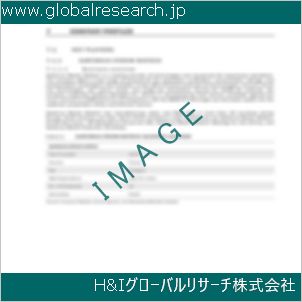Table of Contents
1 Industry Overview of Ethylene
1.1 Definition and Specifications of Ethylene
1.1.1 Definition of Ethylene
1.1.2 Specifications of Ethylene
1.2 Classification of Ethylene
1.3 Applications of Ethylene
1.3.1 Nuclear Application
1.3.2 Non-Nuclear Application
1.4 Industry Chain Structure of Ethylene
1.5 Industry Overview and Major Regions Status of Ethylene
1.5.1 Industry Overview of Ethylene
1.5.2 Global Major Regions Status of Ethylene
1.6 Industry Policy Analysis of Ethylene
1.7 Industry News Analysis of Ethylene
2 Manufacturing Cost Structure Analysis of Ethylene
2.1 Raw Material Suppliers and Price Analysis of Ethylene
2.2 Equipment Suppliers and Price Analysis of Ethylene
2.3 Labor Cost Analysis of Ethylene
2.4 Other Costs Analysis of Ethylene
2.5 Manufacturing Cost Structure Analysis of Ethylene
2.6 Manufacturing Process Analysis of Ethylene
3 Technical Data and Manufacturing Plants Analysis of Ethylene
3.1 Capacity and Commercial Production Date of Global Ethylene Major Manufacturers in 2023
3.2 Manufacturing Plants Distribution of Global Ethylene Major Manufacturers in 2023
3.3 R&D Status and Technology Source of Global Ethylene Major Manufacturers in 2023
3.4 Raw Materials Sources Analysis of Global Ethylene Major Manufacturers in 2023
4 Capacity, Production and Revenue Analysis of Ethylene by Regions, Types and Manufacturers
4.1 Global Capacity, Production and Revenue of Ethylene by Regions 2019-2024
4.2 Global and Major Regions Capacity, Production, Revenue and Growth Rate of Ethylene 2019-2024
4.3 Global Capacity, Production and Revenue of Ethylene by Types 2019-2024
4.4 Global Capacity, Production and Revenue of Ethylene by Manufacturers 2019-2024
5 Price, Cost, Gross and Gross Margin Analysis of Ethylene by Regions, Types and Manufacturers
5.1 Price, Cost, Gross and Gross Margin Analysis of Ethylene by Regions 2019-2024
5.2 Price, Cost, Gross and Gross Margin Analysis of Ethylene by Types 2019-2024
5.3 Price, Cost, Gross and Gross Margin Analysis of Ethylene by Manufacturers 2019-2024
6 Consumption Volume, Consumption Value and Sale Price Analysis of Ethylene by Regions, Types and Applications
6.1 Global Consumption Volume and Consumption Value of Ethylene by Regions 2019-2024
6.2 Global and Major Regions Consumption Volume, Consumption Value and Growth Rate of Ethylene 2019-2024
6.3 Global Consumption Volume and Consumption Value of Ethylene by Types 2019-2024
6.4 Global Consumption Volume and Consumption Value of Ethylene by Applications 2019-2024
6.5 Sale Price of Ethylene by Regions 2019-2024
6.6 Sale Price of Ethylene by Types 2019-2024
6.7 Sale Price of Ethylene by Applications 2019-2024
6.8 Market Share Analysis of Ethylene by Different Sale Price Levels
7 Supply, Import, Export and Consumption Analysis of Ethylene
7.1 Supply, Consumption and Gap of Ethylene 2019-2024
7.2 Global Capacity, Production, Price, Cost, Revenue, Supply, Import, Export and Consumption of Ethylene 2019-2024
7.3 USA Capacity, Production, Price, Cost, Revenue, Supply, Import, Export and Consumption of Ethylene 2019-2024
7.4 EU Capacity, Production, Price, Cost, Revenue, Supply, Import, Export and Consumption of Ethylene 2019-2024
7.5 China Capacity, Production, Price, Cost, Revenue, Supply, Import, Export and Consumption of Ethylene 2019-2024
7.6 Japan Capacity, Production, Price, Cost, Revenue, Supply, Import, Export and Consumption of Ethylene 2019-2024
8 Major Manufacturers Analysis of Ethylene
8.1 Manufacturer One
8.1.1 Company Profile
8.1.2 Product Picture and Specifications
8.1.2.1 Type I
8.1.2.2 Type II
8.1.2.3 Type III
8.1.3 Capacity, Production, Price, Cost, Gross and Revenue
8.1.4 Contact Information
8.2 Manufacturer Two
8.2.1 Company Profile
8.2.2 Product Picture and Specifications
8.2.2.1 Type I
8.2.2.2 Type II
8.2.2.3 Type III
8.2.3 Capacity, Production, Price, Cost, Gross and Revenue
8.2.4 Contact Information
8.3 Manufacturer Three
8.3.1 Company Profile
8.3.2 Product Picture and Specifications
8.3.2.1 Type I
8.3.2.2 Type II
8.3.2.3 Type III
8.3.3 Capacity, Production, Price, Cost, Gross and Revenue
8.3.4 Contact Information
8.4 Manufacturer Four
8.4.1 Company Profile
8.4.2 Product Picture and Specifications
8.4.2.1 Type I
8.4.2.2 Type II
8.4.2.3 Type III
8.4.3 Capacity, Production, Price, Cost, Gross and Revenue
8.4.4 Contact Information
8.5 Manufacturer Five
8.5.1 Company Profile
8.5.2 Product Picture and Specifications
8.5.2.1 Type I
8.5.2.2 Type II
8.5.2.3 Type III
8.5.3 Capacity, Production, Price, Cost, Gross and Revenue
8.5.4 Contact Information
…
9 Marketing Trader or Distributor Analysis of Ethylene
9.1 Marketing Channels Status of Ethylene
9.2 Traders or Distributors with Contact Information of Ethylene by Regions
9.3 Ex-work Price, Channel Price and End Buyer Price Analysis of Ethylene
9.4 Regional Import, Export and Trade Analysis of Ethylene
10 Industry Chain Analysis of Ethylene
10.1 Upstream Major Raw Materials Suppliers Analysis of Ethylene
10.1.1 Major Raw Materials Suppliers with Contact Information Analysis of Ethylene
10.1.2 Major Raw Materials Suppliers with Supply Volume Analysis of Ethylene by Regions
10.2 Upstream Major Equipment Suppliers Analysis of Ethylene
10.2.1 Major Equipment Suppliers with Contact Information Analysis of Ethylene
10.2.2 Major Equipment Suppliers with Product Pictures Analysis of Ethylene by Regions
10.3 Downstream Major Consumers Analysis of Ethylene
10.3.1 Major Consumers with Contact Information Analysis of Ethylene
10.3.2 Major Consumers with Consumption Volume Analysis of Ethylene by Regions
10.4 Supply Chain Relationship Analysis of Ethylene
11 Development Trend of Analysis of Ethylene
11.1 Capacity, Production and Revenue Forecast of Ethylene by Regions and Types
11.1.1 Global Capacity, Production and Revenue of Ethylene by Regions 2024-2029
11.1.2 Global and Major Regions Capacity, Production, Revenue and Growth Rate of Ethylene 2024-2029
11.1.3 Global Capacity, Production and Revenue of Ethylene by Types 2024-2029
11.2 Consumption Volume and Consumption Value Forecast of Ethylene by Regions, Types and Applications
11.2.1 Global Consumption Volume and Consumption Value of Ethylene by Regions 2024-2029
11.2.2 Global and Major Regions Consumption Volume, Consumption Value and Growth Rate of Ethylene 2024-2029
11.2.3 Global Consumption Volume and Consumption Value of Ethylene by Types 2024-2029
11.2.4 Global Consumption Volume and Consumption Value of Ethylene by Applications 2024-2029
11.3 Supply, Import, Export and Consumption Forecast of Ethylene
11.3.1 Supply, Consumption and Gap of Ethylene 2024-2029
11.3.2 Global Capacity, Production, Price, Cost, Revenue, Supply, Import, Export and Consumption of Ethylene 2024-2029
11.3.3 USA Capacity, Production, Price, Cost, Revenue, Supply, Import, Export and Consumption of Ethylene 2024-2029
11.3.4 EU Capacity, Production, Price, Cost, Revenue, Supply, Import, Export and Consumption of Ethylene 2024-2029
11.3.5 China Capacity, Production, Price, Cost, Revenue, Supply, Import, Export and Consumption of Ethylene 2024-2029
11.3.6 Japan Capacity, Production, Price, Cost, Revenue, Supply, Import, Export and Consumption of Ethylene 2024-2029
12 New Project Investment Feasibility Analysis of Ethylene
12.1 New Project SWOT Analysis of Ethylene
12.2 New Project Investment Feasibility Analysis of Ethylene
13 Conclusion of the Global Ethylene (CAS 74-85-1) Industry 2024 Market Research Report
| ※参考情報 エチレン(Ethylene、CAS番号 74-85-1)は、二重結合を有する最小のアルケンであり、化学式はC₂H₄です。無色のガスであり、特有の甘い香りを持ち、常温常圧下では気体の形態をとります。エチレンは、炭素と水素から構成される分子で、化学的に非常に反応性が高く、他の化合物と反応しやすい性質を持っています。これにより、様々な化学反応の原料として広く利用されています。 エチレンの特徴としては、まず低い沸点が挙げられます。沸点は約-104℃であり、このため気体として存在することが一般的です。また、非常に軽量なガスで、空気よりも軽いという特性があります。さらに、エチレンは不飽和化合物であり、その二重結合により、化学反応において多くの反応様式を持つことができます。例えば、ハロゲン化、水素化、ポリマー化などの反応を起こすことができます。 エチレンには、主に二種の製造プロセスがあります。ひとつは、石油精製釜から得られる副産物として生成されるクラッキングプロセスです。もうひとつは、エタノールの脱水反応を通じて得られる方法です。クラッキングプロセスは大量生産において主要な手段とされており、現代の石油化学産業においては欠かせない工程となっています。 エチレンはさまざまな用途を持っています。最も重要な用途は、ポリエチレンなどのプラスチック製品の製造です。ポリエチレンは、包装材、ボトル、ビニールバッグなどに広く使われています。その他にも、合成ゴムや合成繊維、洗剤、農薬、医薬品など、エチレンを原料とするさまざまな化合物が生産されます。特に農業分野においては、エチレンが植物ホルモンとしての働きを持ち、果物や野菜の成熟を促進する効果もあることから、収穫後の処理や保存に利用されています。 また、エチレンは化学工業において重要な中間体としても使用されており、さまざまな化学製品の製造過程において欠かせない材料です。例えば、エチレンオキシドやエチレングリコールなど、エチレンから派生する化合物は、さまざまな産業で利用されています。エチレンオキシドは、消毒剤や合成樹脂の前駆体、エチレングリコールは自動車用冷却剤やプラスチック製品の原料としての役割を果たします。 さらに、エチレンは環境問題とも関係しています。燃焼時に発生する二酸化炭素や一酸化炭素などの温室効果ガスの排出が、地球温暖化に寄与しています。このため、エチレンの製造や使用において持続可能性を考慮した技術の開発が進められています。再生可能エネルギー源からのエチレン製造や、バイオマスからのエチレン合成といった新しいアプローチが模索されており、将来的にはより環境に配慮した形でのエチレンの製造・利用が期待されています。 最後に、エチレンに関連する技術には、エチレンの監視や取り扱いに関する規制や安全基準も含まれます。エチレンは引火性が高いため、取り扱いには慎重を要します。適切な保管と運搬方法、事故防止策が求められます。また、環境への影響を最小限にするための技術やプロセスの改良、エチレン製造におけるエネルギー効率の向上も重要な課題です。 エチレンは、現代社会において非常に重要な化学物質であり、その利用範囲は広く、今後も新たな技術の向上とともに進化し続けることが期待されています。その特性、用途、影響などを理解することは、今後の化学工業や環境問題に対処する上で不可欠です。 |
❖ 免責事項 ❖
http://www.globalresearch.jp/disclaimer












